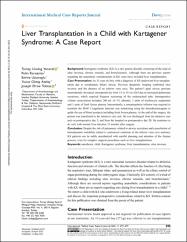| dc.contributor.author | Uludağ Yanaral, Tümay | |
| dc.contributor.author | Karaaslan, Pelin | |
| dc.contributor.author | Uzunoğlu, Emine | |
| dc.contributor.author | Atalay, Yunus Oktay | |
| dc.contributor.author | Tobias, Joseph Drew | |
| dc.date.accessioned | 2021-06-10T07:29:39Z | |
| dc.date.available | 2021-06-10T07:29:39Z | |
| dc.date.issued | 2021 | en_US |
| dc.identifier.citation | Uludağ Yanaral, T., Karaaslan, P., Uzunoğlu, E., Atalay, Y. O. ve Tobias, J. D. (2021). Liver transplantation in a child with kartagener syndrome: A case report. International Medical Case Reports Journal, 14, 295-299. https://dx.doi.org/10.2147/IMCRJ.S311843 | en_US |
| dc.identifier.issn | 1179-142X | |
| dc.identifier.uri | https://dx.doi.org/10.2147/IMCRJ.S311843 | |
| dc.identifier.uri | https://hdl.handle.net/20.500.12511/7120 | |
| dc.description.abstract | Background: Kartagener syndrome (KS) is a rare genetic disorder consisting of the triad of situs inversus, chronic sinusitis, and bronchiectasis. Although there are previous reports regarding the anaesthetic considerations in KS, none have included liver transplantation. Case Presentation: An 11-year-old boy with a diagnosis of KS underwent liver transplantation due to extrahepatic biliary atresia. Previous diagnostic imaging confirmed situs inversus and the absence of an inferior vena cava. The patient's peak airway pressure intermittently increased intraoperatively from 15 to 30 cm H2O due to increased pulmonary secretions, which required frequent suctioning of the endotracheal tube. Intraoperative volume resuscitation included 200 mL of 5% albumin, 5 units of erythrocyte suspension and 3 units of fresh frozen plasma. Intermittently, a norepinephrine infusion was required to maintain the MAP. Coagulation function was monitoring using the thromboelastogram to guide the use of blood products including fresh frozen plasma. At the end of the surgery, the patient was transferred to the intensive care unit. He was discharged from the intensive care unit on postoperative day 5, and from the hospital on postoperative day 28. He continues to do well with normal liver function 23 months after surgery. Conclusion: Despite the risk of pulmonary related to airway secretions and exacerbation of hemodynamic instability related to anatomical variations in the inferior vena cava anatomy, KS patients can be safely anesthetized with careful planning and attention of the disease process, even for complex surgical procedures such as liver transplantation. | en_US |
| dc.language.iso | eng | en_US |
| dc.publisher | Dove Medical Press Ltd | en_US |
| dc.rights | info:eu-repo/semantics/openAccess | en_US |
| dc.rights | Attribution-NonCommercial 3.0 Unported | * |
| dc.rights.uri | https://creativecommons.org/licenses/by-nc/3.0/ | * |
| dc.subject | Anesthesia | en_US |
| dc.subject | Child | en_US |
| dc.subject | Kartagener Syndrome | en_US |
| dc.subject | Liver Transplantation | en_US |
| dc.subject | Situs Inversus | en_US |
| dc.title | Liver transplantation in a child with kartagener syndrome: A case report | en_US |
| dc.type | article | en_US |
| dc.relation.ispartof | International Medical Case Reports Journal | en_US |
| dc.department | İstanbul Medipol Üniversitesi, Tıp Fakültesi, Cerrahi Tıp Bilimleri Bölümü, Anesteziyoloji ve Reanimasyon Ana Bilim Dalı | en_US |
| dc.authorid | 0000-0003-3917-8183 | en_US |
| dc.authorid | 0000-0002-5273-1871 | en_US |
| dc.authorid | 0000-0001-9146-0915 | en_US |
| dc.authorid | 0000-0001-9928-9956 | en_US |
| dc.identifier.volume | 14 | en_US |
| dc.identifier.startpage | 295 | en_US |
| dc.identifier.endpage | 299 | en_US |
| dc.relation.publicationcategory | Makale - Uluslararası Hakemli Dergi - Kurum Öğretim Elemanı | en_US |
| dc.identifier.doi | 10.2147/IMCRJ.S311843 | en_US |
| dc.identifier.scopusquality | Q3 | en_US |



















